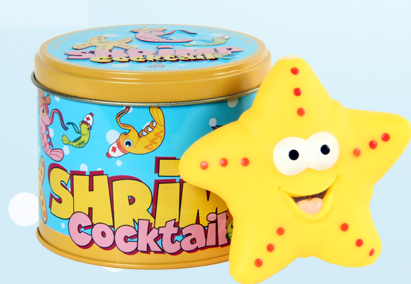Game Review: "Shrimp Cocktail" for Both Visual Perception and Speech-Language Goals
by Anne Zachry, Ph.D., OTR/L and Kristin Lyons MA CF-SLP

Recently I sat down with two of my students who have visual perceptual processing problems and played a game of “Shrimp Cocktail” by Blue Orange Games
Rules of the Game: This game is for ages 7 and up and is for 2 to 6 players. Begin by mixing up the cards and dividing them as evenly as possible between players, placing the cards face down. The three “fishing zone” cards should be placed in the middle of the group. The squeaky starfish should also be placed in the center so that all players can reach it.
The shrimp on the cards have different characteristics: sizes, number, color, and nationality. Look at all of the cards and find a common characteristic.
How to Play: To begin the game, the first player places a card on top of one of the “fishing zone” cards, and the subsequent players quickly follow suit. Once the three cards have been placed, the players scan the cards for 3 common characteristics. The first player to find the commonalities squeezes the squeaky starfish and immediately names the common characteristics (there may be one or more common characteristics). If correct, he keeps the three cards. The game is over if someone spots a “shrimp cocktail” (this is when the total number of shrimp on the three cards equals seven), or when the cards are all placed. The player with the most cards wins.
Little did my students know, they were working on a variety of skills, including the ability to respond quickly, visually scan, categorize, and discriminate. However, the game moves quickly, so it may need to be adapted for children with slower processing skills. One suggestion is to have the therapist place the cards, rather than having the students do this. This will allow them to pay more attention and look for similarities.
I shared the game with the speech therapist that I work with and this is what she had to say about the game.
When my fifth grade students played, they were a little too aggressive. It wasn’t about spotting the common characteristic – it was all about winning (getting the starfish first, and then scrambling to spot the commonality).
My third graders were almost the exact opposite. They were really receptive to the actual point of the game. They waited to touch the starfish until they spotted the common characteristic.
Overall, I think the game is fun, and with the right group, it could be incorporated into therapy successfully. I used it with students with articulation and language goals, and I liked that I could adapt it to these different groups.
Buy this Game on Amazon.com
Featured Contributor: Dr. Anne Zachry, OTR/L PhD
Dr. Anne Zachry is a pediatric occupational therapist with over 18 years experience providing quality OT to children, along with caregiver instruction and support. She has a PhD in Educational Psychology. She’s had articles published in her profession’s trade magazine and in peer-reviewed journals. She is currently employed as a school therapist, working with students having issues ranging from mild fine motor problems to severe physical disabilities.
Please support our contributing authors and visit Pediatric Occupational Therapy Tips
PediaStaff is Hiring!
All JobsPediaStaff hires pediatric and school-based professionals nationwide for contract assignments of 2 to 12 months. We also help clinics, hospitals, schools, and home health agencies to find and hire these professionals directly. We work with Speech-Language Pathologists, Occupational and Physical Therapists, School Psychologists, and others in pediatric therapy and education.
